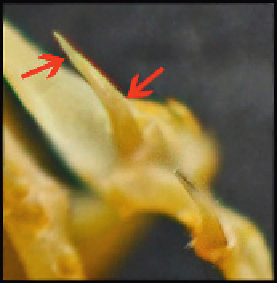Biology Reference
In-Depth Information
(C)
(D)
Plate 4.49
(C and D) Enlarged posterior maxillary teeth of
Tachymenis peruviana
.
The
most posterior (the last two teeth in the maxilla) enlarged maxillary teeth are gently recurved
and contain a shallow groove that extends over almost the entire length of the tooth.
Plate 4.49C and D, AMNH #5256, photo copyright to Arie Lev.
shallow groove present on approximately two-thirds of their length (Plate 4.49C and
D). There are no well-documented cases of medically significant bites from this spe-
cies; anecdotal reports suggest only mild-to-moderate local effects (Warrell, 2004).
One published paper frequently cited in support of a fatal envenomation by this
species (Vellard, 1955) mentions no human fatality. Rather, the paper describes the
effects of
T. peruviana
secretion on experimental animals (Vellard, 1955). There
is, therefore, no evidence whatsoever of serious envenomation in humans from a
T. peruviana
bite. The report by Vellard (1955) should only be cited in relation to
experimentally induced effects of
T. peruviana
secretion in animals. It must not be
propagated in the literature as evidence of a “fatal bite” that in fact did not occur.
4.3.4.2
Oligodon arnensis
: Deadly Fear Without a Cause?
The colubrine genus
Oligodon
(kukri snakes;
Plate 4.67A and B
) consists of approxi-
mately 68 species that feed on a variety of small vertebrates and invertebrates includ-
ing nestling birds and their eggs, lizards and their eggs, frogs, and occasionally large
insects (diet varies according to species).
Oligodon
spp. have a wide range in northern to
western Asia, Southeast Asia, and the Indian subcontinent, and most average
89 cm in
length (Cox, 1991; Smith, 1943; Wall, 1921;
www.toxinology.com
)
. There are no well-
documented cases of medically significant bites from these snakes (Viravan et al., 1992).
However, a case described by Wall (1921) has been cited as possible evidence of a fatal
envenomation from a bite by the common, russet, or banded kukri snake,
O. arnensis
,
near Bannu, Khyber-Pakhtunkhwa Province, Pakistan. The victim was described as hav-
ing received a bite on the buttocks after lying down on his bed on the ground:
“He jumped up immediately rubbing his buttock, and declared that something had bit-
ten him there. His companions searched his bedding, and there found a snake which
they killed. They examined him, but could see no signs of a bite, and tried to persuade




